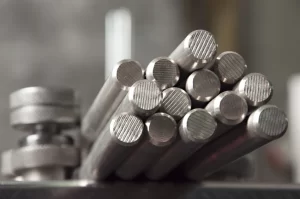Introduction
Machining stainless steel is a craft that demands precision and insight, especially when dealing with unique grades like 410 stainless steel. In this comprehensive guide, we delve into the world of machining 410 stainless steel, exploring its composition, challenges, precautions, and best practices to ensure successful machining operations.
Demystifying Machining: A Balance of Art and Science
 Machining stainless steel involves more than just cutting metal—it’s a fusion of art and science, where understanding material properties and mastering machining techniques converge. In this intricate dance, 410 stainless steel emerges as a unique partner with its own set of challenges and attributes.
Machining stainless steel involves more than just cutting metal—it’s a fusion of art and science, where understanding material properties and mastering machining techniques converge. In this intricate dance, 410 stainless steel emerges as a unique partner with its own set of challenges and attributes.
Understanding the Composition of 410 Stainless Steel
The elemental composition of 410 stainless steel influences its machinability. With higher carbon content and the presence of chromium, this grade offers both advantages and complications in machining operations.
Challenges of Machining 410 Stainless Steel
Machining 410 stainless steel isn’t without its hurdles. Its hardness, tendency to work-harden, and sensitivity to heat necessitate a strategic approach to overcome challenges and produce high-quality machined components.
Precautions for Successful Machining Operations
Precautions play a pivotal role in successful machining of 410 stainless steel. Key considerations include:
- Stable Setup: Ensure a rigid setup to minimize vibrations and maintain precision.
- Heat Management: Control heat generation to prevent work hardening and reduce tool wear.
- Tool Selection: Choose appropriate tool materials and coatings to withstand the demands of machining 410 stainless steel.
Choosing the Right Tools: The Tooling Dilemma
Tool selection is paramount when machining 410 stainless steel. Hardened tool steels with carbide inserts are common choices, but coatings and geometry also influence tool performance.
Cutting Speeds and Feeds: Finding the Sweet Spot
Balancing cutting speeds and feeds is essential. High cutting speeds can generate heat, while low speeds might lead to poor chip control. Finding the optimal balance ensures efficient material removal without compromising tool life.
Coolant Selection and Management: Cooling the Heat
Coolants play a dual role in machining 410 stainless steel: they lubricate and cool. Choosing the right coolant and managing its application effectively prevent overheating and extend tool life.
Surface Finish and Chip Control: Navigating Challenges
 Achieving desired surface finishes while managing chip formation is a delicate balance. Proper chip evacuation prevents chip buildup and ensures smooth machining operations.
Achieving desired surface finishes while managing chip formation is a delicate balance. Proper chip evacuation prevents chip buildup and ensures smooth machining operations.
Comparative Analysis: Machining 410 vs. Other Stainless Steel Grades
Comparing the machining of 410 stainless steel with other grades reveals unique challenges:
- Austenitic Grades: Generally easier to machine due to lower carbon content.
- Ferritic Grades: Share some challenges with 410 stainless steel, but variations exist in work hardening and sensitivity to heat.
Machining Excellence: A Symphony of Skill and Knowledge
Machining 410 stainless steel demands mastery of technique and understanding of material behavior. Professionals must orchestrate factors like tool selection, cutting parameters, and coolant application to achieve precision and efficiency.
FAQs About Machining 410 Stainless Steel
Q1: Can I use the same tools for machining 410 stainless steel as for other grades?
Tool selection varies based on the grade’s properties. While some tools might overlap, the unique challenges of 410 stainless steel demand specialized tooling for optimal results.
Q2: How can I prevent work hardening during machining?
Controlling cutting speeds, feeds, and using appropriate cooling techniques can help manage heat generation and prevent work hardening during machining.
Q3: Can I achieve the same surface finish with 410 stainless steel as with other grades?
Achieving the desired surface finish might require adjustments due to 410 stainless steel’s hardness and sensitivity. Proper tooling, speeds, feeds, and coolant application are crucial.
Conclusion
Machining 410 stainless steel is an art of precision and understanding, where a symphony of factors harmonize to create high-quality machined components. It’s a dance that demands meticulous tool selection, cutting parameters, and coolant management to conquer challenges like hardness and heat sensitivity. Armed with knowledge and finesse, machining professionals can transform 410 stainless steel into intricate parts that stand as testaments to their expertise.
